Why You Should consider Using a Commercial Air Purifier – The Facts?

HEPA filters have remained the gold standard for air purification since the 1950s. Despite their widespread use, the indoor transmission of airborne viruses, particularly those responsible for COVID, has persisted.
During the various waves of the coronavirus pandemic, there has been COVID transmission occurring in acute care centers when public health guidelines were not followed. This was especially true in the Canadian province of Quebec, during the first COVID wave. Interestingly, there have been miscellaneous outbreaks in hospital clinics and hospital offices too, like the one at the Foothills Medical Centre in Calgary, Canada. These examples illustrate that the current HVAC systems used in most hospitals and commercial settings may not be as effective as previously thought. There are various commercial air purifier upgrades available that can improve this.
Why current HVAC systems may be of limited efficacy
If High Efficiency Particulate in Air (HEPA) filters are so effective at removing harmful particulate from the air, why has there been so much transmission in places that use them? This question is a rather baffling one. HEPA filters boast a 99% efficacy rate at removing airborne particles down to 0.1 micrometers in size. Therefore, they should be able to trap SARS-CVD-2, the virions responsible for COVID, that are about 0.15 micrometers. It would seem logical to expect reduced transmission in environments that use HEPA-based commercial air purifiers, right?
Numerous 2020 studies from Asia show that certain HVAC systems generate airflows that enhance the spread of the virus. While the presence of HEPA filters was not constant across all settings examined, these studies do illustrate the limitations of re-circulated air. Suppose you are working in a space that is 300 cubic meters. It might take the HVAC system 1 hour to purify all the air in that space. Maybe one worker coughs into his or her elbow. Suppose, then, that one stray aerosol escapes the clutch of the elbow and is swept toward an adjacent colleague via the airflows of HVAC fans. The commercial air purifier is now acting as a spreader.
How new HVAC technologies can help
Systems that bring in outdoor air are better than ones that rely solely on re-circulation. Ultraviolet light contains a class of waves, known as the C rays, which denature the protein production complexes of the virions upon exposure, rendering them innocuous. This means that for every one-hour purification cycle that brings in outdoor air, the total air volume gets replaced by air that has been exposed to UV rays from outside. The presence of the outdoor air will reduce the likelihood of transmission because there is greater probability of the virions being dissolved away by the new air as they travel down a transmission pathway. In places where the climate is too cold to bring in outside air, the effects can be imitated with the use of UV reactor chambers in commercial air purifiers or HVAC units. These work by exposing the re-circulated air to UV-C rays, often by attaching them to HVAC ducts. Because the air is continually exposed to UV rays as it circulates, this sets the stage for potential displacement and dissolution of the virions, in much the same way that outdoor air exposure would.
One could bring in outside air, and then have UV reactor chambers installed on all ducts that receive indoor air. This way, every airflow pathway in the system would involve UV exposure. If two workers are staggered within the same pathway, however, there could still be worker-to-worker transmission. One could solve this problem by placing free-standing tower purifiers with UV chambers between the clusters of workers. Regardless of which solution is the most logistically feasible, modern commercial air purifiers stand to benefit a great deal by making use of UV reactor technology. Had the acute care centers in Quebec used this technology, maybe some lives would have been saved.
Commercial air purifiers are excellent tools for businesses, whether they are in healthcare or not. Cleaning the air in workspaces will always have a positive impact on your employees and their wellbeing. Consider the benefits of emerging technology and how incorporating UV technology into your existing air quality system can keep your employees healthier, and even safer.







